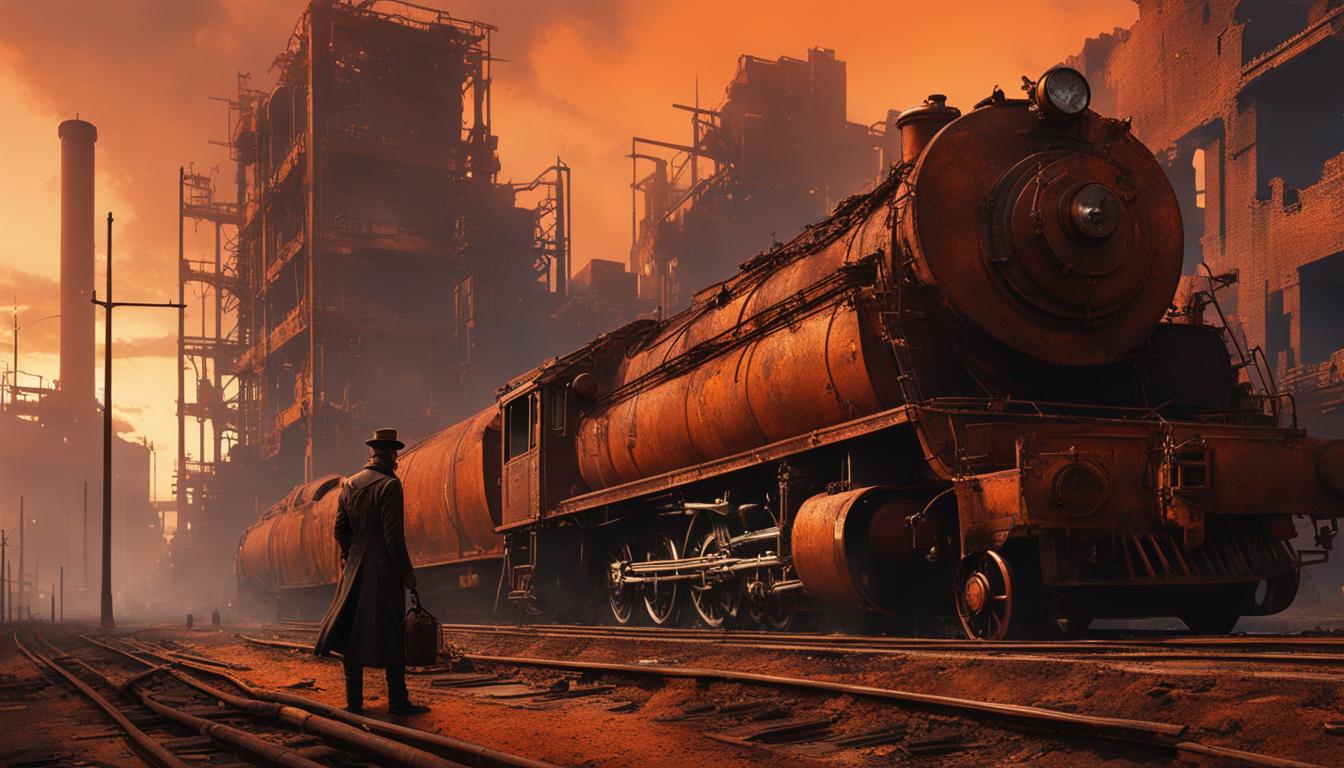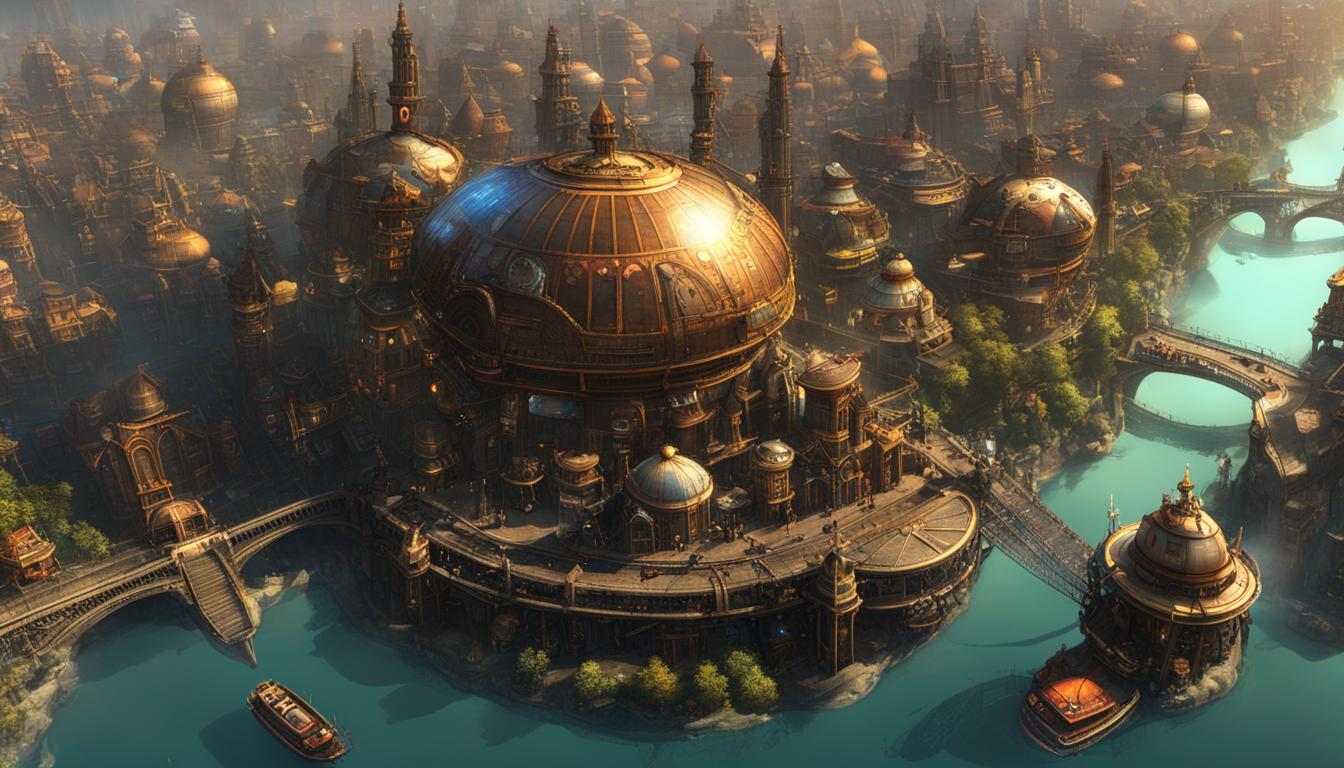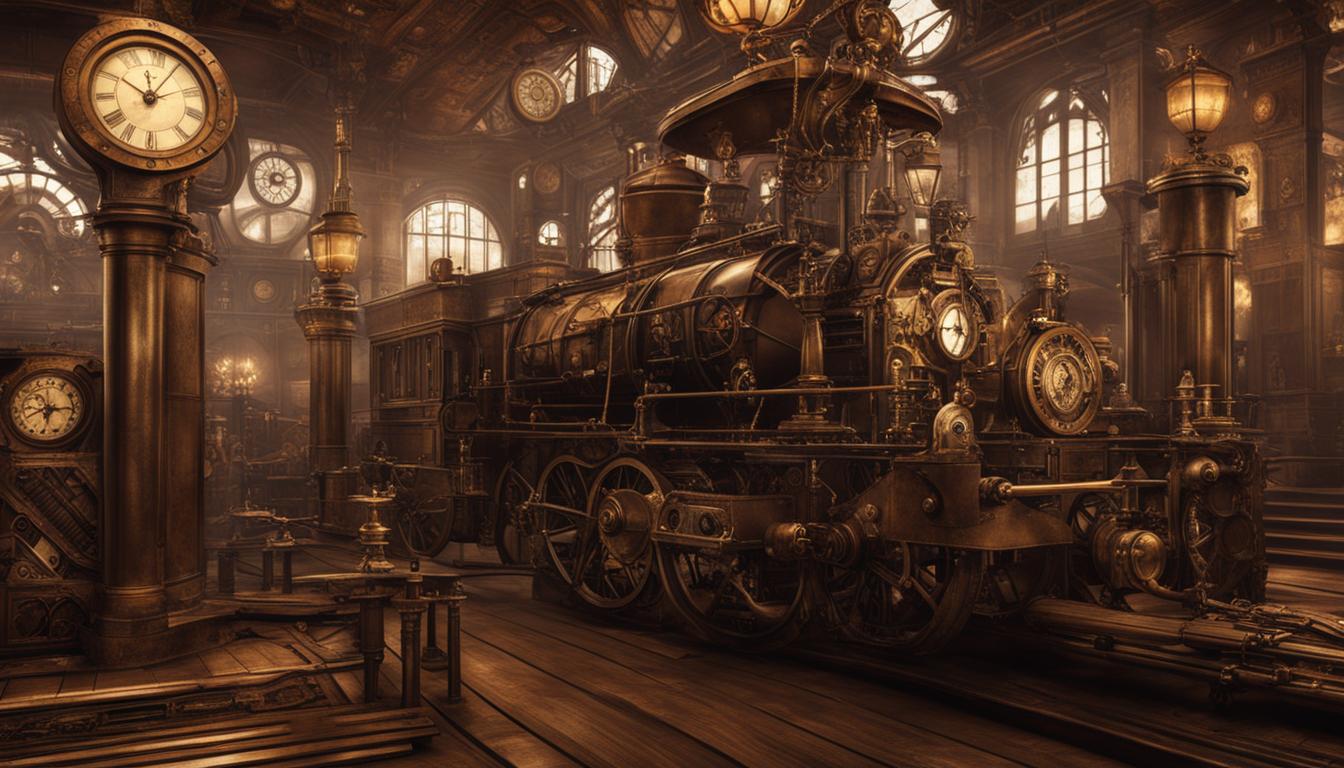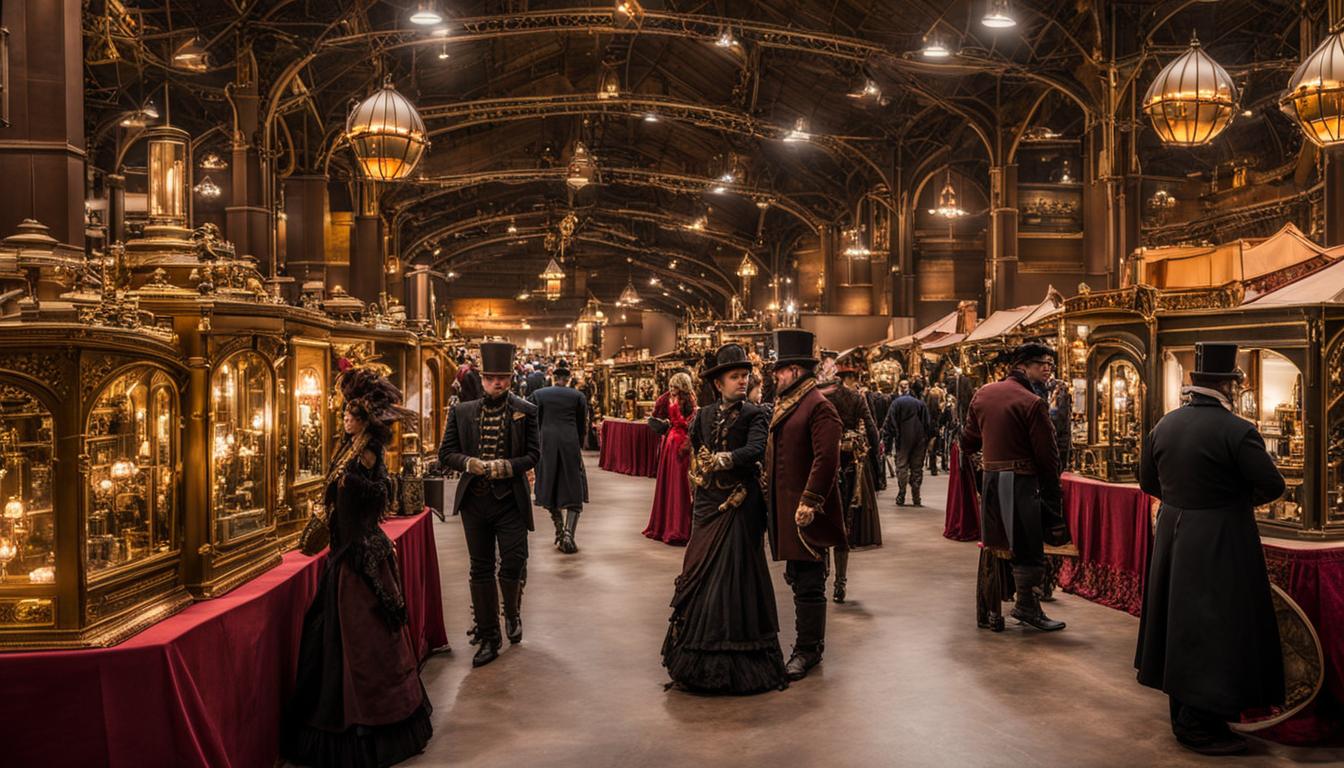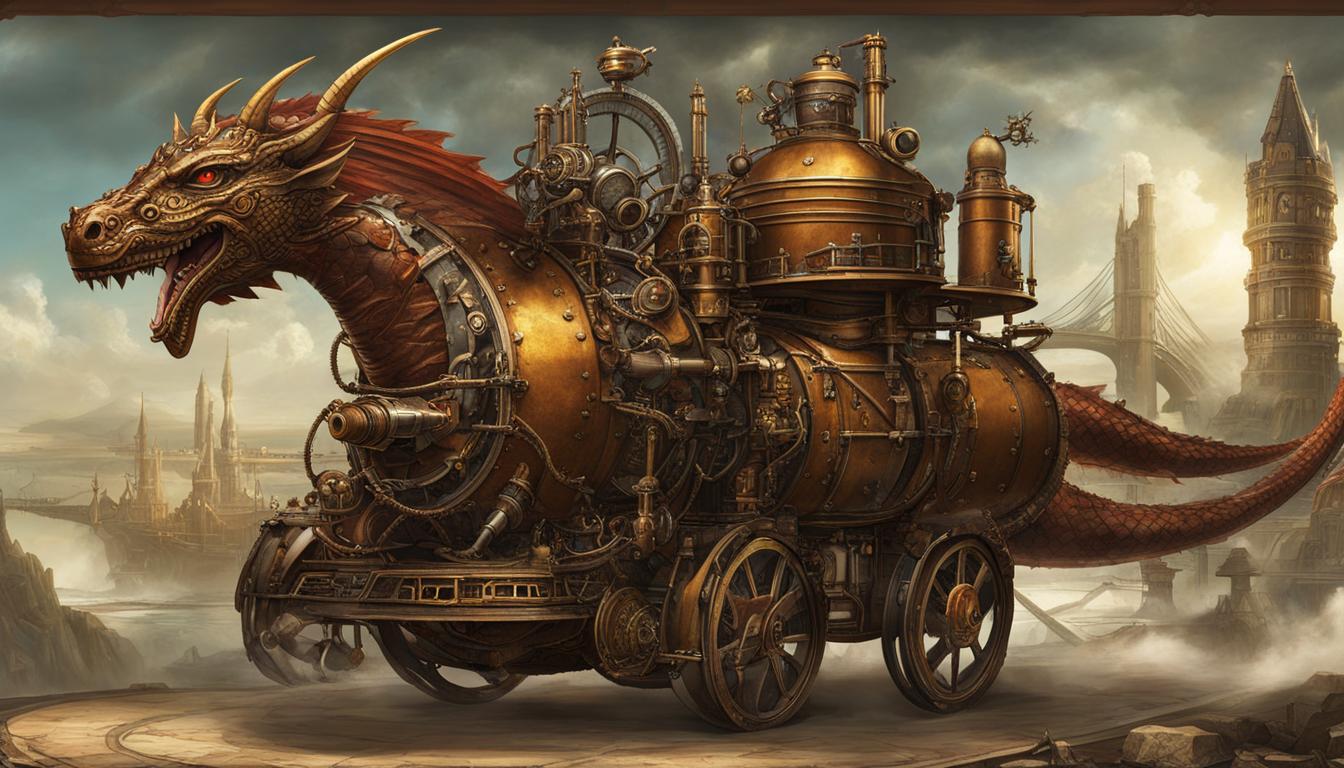Unleash the imagination and embark on a thrilling journey through the realms of steampunk and post-apocalyptic media. This article delves deep into the fascinating worlds where steam-powered marvels collide with dystopian landscapes. Prepare to be captivated by the blend of Victorian aesthetics, post-apocalyptic themes, and the enigmatic allure that lies within.
Key Takeaways:
- Steampunk and post-apocalyptic media offer a unique blend of Victorian-inspired aesthetics and dystopian narratives.
- Explore the origins and characteristics of steampunk, its transition from literature to other media forms, and how it incorporates post-apocalyptic elements.
- Uncover the cultural significance of the fusion between steampunk and post-apocalyptic genres and the impact they have on popular culture.
- Discover the historical foundations of both genres, drawing inspiration from relevant historical events and periods.
- Appreciate the visual and thematic elements that define steampunk and post-apocalyptic media, showcasing their influence on fashion, art, and more.
The Cultural Significance of Steampunk and Post-Apocalyptic Media
Steampunk and post-apocalyptic media have become increasingly influential in contemporary popular culture. The fusion of the steampunk and post-apocalyptic genres has resulted in captivating narratives that combine elements of both worlds. Post-apocalyptic narratives in steampunk stories offer a unique perspective, exploring the consequences of societal collapse and the resilience of human ingenuity in a world dominated by steam-powered machinery.
Combining steampunk with post-apocalyptic settings creates a rich tapestry of storytelling possibilities. Steampunk themes such as Victorian aesthetics, alternate history, and the clash of man and machine are seamlessly integrated into post-apocalyptic landscapes, adding depth and intrigue to the narrative. The juxtaposition of advanced steam technology against the backdrop of a devastated world creates a visually striking and thematically complex experience for audiences.
Furthermore, the fusion of these two genres allows for thought-provoking explorations of societal issues. The post-apocalyptic element in steampunk stories serves as a metaphor for the fragility of civilization and the potential consequences of unchecked industrialization. It prompts audiences to reflect on the role of technology in society and raises questions about environmental sustainability and social inequality.
| Table: Steampunk and Post-Apocalyptic Genre Fusion | Table: Combining Steampunk with Post-Apocalyptic Worlds |
|---|---|
| ✓ Blending of steampunk and post-apocalyptic themes | ✓ Integration of Victorian aesthetics in post-apocalyptic landscapes |
| ✓ Exploration of societal collapse and human resilience | ✓ Juxtaposition of advanced steam technology and devastated environments |
| ✓ Metaphorical reflection on the consequences of unchecked industrialization | ✓ Prompting audience reflection on the role of technology and social issues |
Steampunk and post-apocalyptic media have captivated audiences with their unique blend of historical influences, innovative storytelling, and striking visual aesthetics. The fusion of these genres offers a fresh perspective on familiar themes and allows for imaginative explorations of human nature, societal collapse, and the potential consequences of technological progress.
Steampunk and Post-Apocalyptic Narratives
Within the steampunk genre, there is a wide range of narratives that incorporate post-apocalyptic elements. Some stories focus on the aftermath of a catastrophic event, exploring how society rebuilds itself in a steampunk setting. Others depict a world on the brink of collapse, teetering between the remnants of the past and the uncertain future. These narratives often delve into themes of survival, exploration, and the resilience of the human spirit.
Combining steampunk with post-apocalyptic worlds offers storytellers the opportunity to create intricate and immersive settings that captivate audiences. Whether it’s the decaying remnants of once-grand cities or the untamed wilderness reclaimed by nature, these worlds showcase the creativity and imagination of the creators. They provide a backdrop in which characters navigate a dangerous and unpredictable landscape, confronting their own fears and desires in the process.
- Post-apocalyptic narratives in steampunk stories open up discussions on societal collapse and human resilience.
- Combining steampunk with post-apocalyptic worlds creates visually striking and thematically complex experiences.
- These narratives prompt reflection on the consequences of unchecked industrialization and technological advancement.
Overall, the cultural significance of steampunk and post-apocalyptic media lies in their ability to captivate audiences with their unique blend of aesthetics, storytelling, and thought-provoking themes. The fusion of these genres offers a fresh take on familiar tropes, providing audiences with a rich and immersive experience that invites reflection on the past, present, and future.
The Aesthetics of Steampunk and Post-Apocalyptic Media
Steampunk and post-apocalyptic media share a common thread in their striking aesthetics, which play a crucial role in creating immersive and visually captivating worlds. In steampunk, the focus is on blending the elements of Victorian-era aesthetics, technology, and industrial design with futuristic and fantastical elements. With its intricate clockwork mechanisms, brass goggles, corsets, and gears, steampunk has become synonymous with a unique retro-futuristic look.
In post-apocalyptic media, on the other hand, the aesthetics are shaped by the aftermath of a catastrophic event. These worlds are often depicted as desolate, worn, and decayed, with remnants of the past mingling with makeshift structures. The visual language of post-apocalyptic settings reflects the struggle for survival, with rugged clothing, scavenged items, and a sense of resourcefulness.
“In steampunk, we see a juxtaposition of anachronistic elements with advanced technology, while in post-apocalyptic media, we witness the collision of civilization and destruction,” says Dr. Emily Sullivan, a cultural historian specializing in speculative fiction. “Both genres incorporate these aesthetics to evoke a sense of wonder, mystery, and possibility.”
Steampunk Themes in Post-Apocalyptic Literature
The influence of post-apocalyptic settings can be seen in steampunk literature, where authors often reimagine the world after a catastrophic event, incorporating it into the steampunk framework. In these stories, the steampunk aesthetic blends with the remnants of a post-apocalyptic landscape, resulting in a unique fusion of themes.
For example, in Philip Reeve’s “Mortal Engines” series, the world is set in a post-apocalyptic future where cities roam the wastelands as giant mobile machines. The combination of advanced steam-powered technology and the remnants of a devastated world creates a one-of-a-kind steampunk/post-apocalyptic hybrid.
Moreover, the post-apocalyptic influence on steampunk storytelling extends beyond literature. In films like “The City of Lost Children” and “Nine,” the desolate and decaying landscapes serve as backdrops to elaborate machinery and fantastical steampunk inventions, further blurring the lines between the two genres.
| Steampunk Themes | Post-Apocalyptic Themes |
|---|---|
| Victorian aesthetics | Desolation and decay |
| Advanced technology | Scavenging and resourcefulness |
| Adventure and exploration | Survival and hardship |
As the table above illustrates, while they have distinct aesthetics, steampunk and post-apocalyptic media also share common themes that enable their seamless blending. The combination of these themes creates a unique narrative and visual landscape that has captivated audiences around the world.
The Historical Foundations of Steampunk and Post-Apocalyptic Media
Steampunk and post-apocalyptic media draw inspiration from historical events and periods, giving them a unique and captivating allure. The historical origins of steampunk can be traced back to the Industrial Revolution, a time of great technological advancements and societal changes. This era of steam-powered machinery, Victorian fashion, and elaborate architecture serves as the foundation for the steampunk genre. By reimagining this historical period, steampunk stories transport readers to an alternative universe where steam-driven technology reigns supreme.
On the other hand, post-apocalyptic narratives find inspiration in historical events that have shaped our world. The destruction caused by wars, natural disasters, or societal collapse serves as the backdrop for these stories. Post-apocalyptic media often explores themes of survival, human resilience, and the consequences of our actions. By drawing from historical inspirations, post-apocalyptic narratives reflect our collective fears and address pertinent issues of our time.
The Historical Origins of Steampunk
Steampunk has its roots in the works of authors such as Jules Verne and H.G. Wells, who envisioned a future where steam-powered technology played a prominent role. These early science fiction pioneers set the stage for the development of steampunk as a distinct genre. In their novels, they showcased a world where airships floated through the sky, mechanical contraptions performed astonishing feats, and Victorian sensibilities collided with futuristic visions.
“Steampunk is like historical science fiction on steroids. It takes the romanticized aspects of the past and amplifies them with fantastical embellishments.”
The cultural and technological advancements of the Victorian era, with its intricate fashion, architecture, and industrial progress, are also significant influences on steampunk aesthetics. By combining historical elements with futuristic imaginings, steampunk offers a visually stunning and thought-provoking experience for readers and viewers alike.
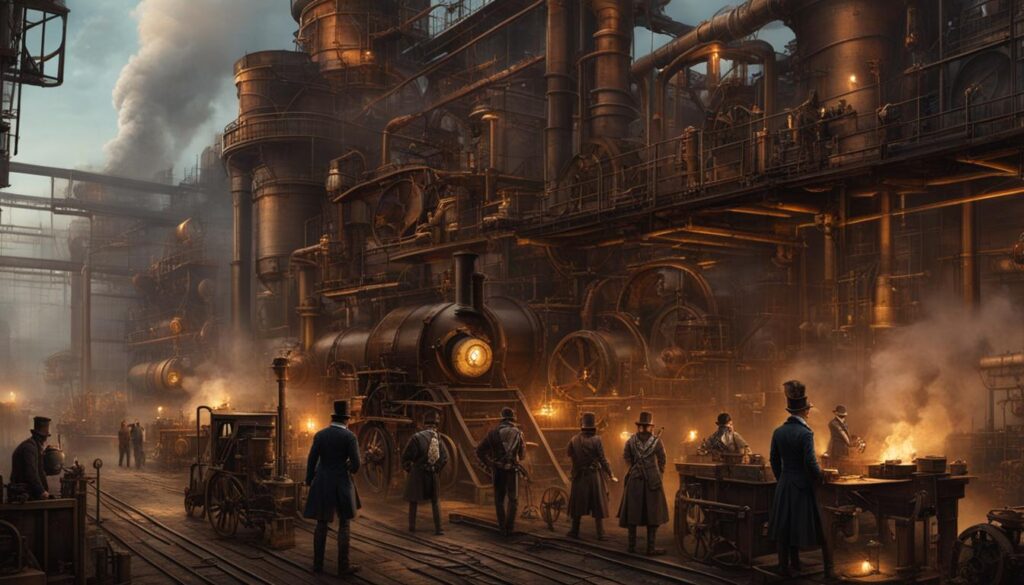
| Steampunk | Post-Apocalyptic |
|---|---|
| Alternative history | Dystopian future |
| Steam-powered technology | Scarcity and survival |
| Victorian aesthetics | Decay and destruction |
| Adventure and exploration | Human resilience |
The table above highlights some of the contrasting elements between steampunk and post-apocalyptic media. While steampunk offers an alternate history with fantastical technology, post-apocalyptic narratives focus on the aftermath of catastrophic events and the human struggle for survival. Both genres draw on historical inspirations, but their interpretation and portrayal of the past and future differ significantly.
The Cultural Impact of Steampunk and Post-Apocalyptic Media
Steampunk and post-apocalyptic media have transcended their genres and made a significant impact on popular culture. These unique and captivating genres have influenced various aspects of society, leaving a lasting legacy that extends far beyond their fictional worlds.
The cultural significance of steampunk and post-apocalyptic media can be seen in fashion trends that draw inspiration from their distinct aesthetics. From corsets and goggles to leather jackets and gas masks, these genres have inspired alternative fashion movements that embrace the whimsical and the gritty. Steampunk-inspired fashion can be spotted at conventions, festivals, and even on the streets, with individuals expressing their creativity through unique and imaginative attire.
“Steampunk has transcended from being just a genre of fiction to becoming a lifestyle for many,” says fashion historian Dr. Amelia Anderson. “It’s a way for people to embrace a sense of nostalgia for the past while also embracing their own individuality and creativity.”
Music has also been impacted by the steampunk and post-apocalyptic genres, with bands and musicians incorporating their themes into their lyrics, visuals, and performances. From the theatricality and storytelling of steampunk-inspired bands to the dark and gritty soundscapes of post-apocalyptic-inspired music, these genres have expanded the boundaries of musical expression.
| Impact on Popular Culture | Examples |
|---|---|
| Television and Film | The success of TV shows like “Westworld” and “The Man in the High Castle” showcases the enduring popularity of these genres on the small screen. Meanwhile, films like “Mad Max: Fury Road” and “The Mortal Engines” demonstrate the visual grandeur and imaginative worlds that can be brought to life through steampunk and post-apocalyptic storytelling. |
| Literature | Authors like Philip Reeve and Gail Carriger have gained immense popularity with their steampunk and post-apocalyptic novels, captivating readers with their unique storytelling and vivid world-building. Their works have spurred a wave of new authors exploring these genres, further expanding their cultural impact. |
| Video Games | Popular video games like “Bioshock” and “Fallout” have embraced the steampunk and post-apocalyptic aesthetics and narratives, immersing players in rich and immersive gaming experiences. These games have not only achieved critical acclaim but have also attracted a massive and dedicated fanbase. |
The impact of steampunk and post-apocalyptic media on architecture can also be witnessed in the design of certain buildings and venues. Steampunk-inspired cafes, bars, and event spaces create immersive environments that transport visitors to fantastical worlds where steam-powered contraptions and Victorian-era charm reign supreme.
Overall, the cultural impact of steampunk and post-apocalyptic media cannot be overstated. These genres have influenced not only entertainment but also fashion, music, literature, and architecture. Their enduring popularity and continued exploration by creators and enthusiasts ensure that their impact will be felt for years to come.
Conclusion
As we conclude this article, we find ourselves immersed in the captivating worlds of steampunk and post-apocalyptic media. Through our exploration, we have uncovered the similarities and differences between these two genres, witnessing the fusion of steampunk with post-apocalyptic themes and the resulting creation of unique storytelling experiences.
Steampunk and post-apocalyptic media have not only left their mark on the cultural landscape but have also revolutionized popular culture in profound ways. Their impact can be seen in fashion trends that embrace the Victorian aesthetic blended with futuristic elements, as well as in the music that echoes the mechanical symphonies of a bygone era.
Their influence extends beyond mere entertainment, seeping into the depths of architecture and art. It is in the towering clockwork structures and the hauntingly beautiful post-apocalyptic art pieces that we witness the ingenuity and imagination sparked by these genres.
By examining the intricate worlds of steampunk and post-apocalyptic media, we have unraveled their historical foundations, appreciated their unique aesthetics, and revealed the indelible cultural impact they have had on society. Whether it’s the fusion of genres, the themes interwoven in post-apocalyptic literature, or the lasting legacy on popular culture, we stand in awe at the allure and mystique of steampunk and post-apocalyptic media.
FAQ
What is steampunk?
Steampunk is a subgenre of science fiction that emerged in the eighties. It features dystopian universes with steam-powered machinery inspired by the industrial revolution.
What are the characteristics of steampunk?
Steampunk stories typically include a blend of Victorian-era aesthetics, advanced steam-powered technology, and alternate history elements.
How does steampunk incorporate post-apocalyptic themes?
Steampunk stories often portray post-apocalyptic settings where the dystopian elements are brought on by a catastrophic event that alters the course of history.
How is steampunk portrayed in post-apocalyptic literature and media?
In post-apocalyptic stories, steampunk elements are often used to depict a world struggling to rebuild itself after the collapse of civilization, with characters utilizing steam-powered technology in their survival efforts.
What is the fusion of steampunk and post-apocalyptic genres?
The fusion of steampunk and post-apocalyptic genres involves incorporating post-apocalyptic narratives into steampunk stories, creating a unique blend of dystopian and retro-futuristic elements.
How are post-apocalyptic narratives incorporated into steampunk stories?
Post-apocalyptic elements are often integrated into steampunk stories through the introduction of ruined cities, scavenging for resources, and the exploration of the aftermath of cataclysmic events.
How are steampunk themes portrayed in post-apocalyptic literature and media?
Steampunk themes in post-apocalyptic literature and media often emphasize the contrast between the decay of society and the persistence of steampunk technology, highlighting the struggle for survival against a backdrop of retro-futuristic aesthetics.
What are the visual and thematic elements that characterize steampunk and post-apocalyptic media?
Steampunk and post-apocalyptic media share visual and thematic elements such as desolate landscapes, gritty technology, industrial aesthetics, and a sense of adventure in a harsh world.
How does the post-apocalyptic genre influence the overall aesthetic of steampunk?
The post-apocalyptic genre often infuses steampunk with a darker and grittier aesthetic, reflecting the decay and desperation of a post-catastrophe world.
What historical events and periods inspire steampunk?
Steampunk takes inspiration from the Victorian era and the industrial revolution, reimagining historical contexts with advanced steam-powered technology and alternative history elements.
What historical inspirations are behind post-apocalyptic narratives?
Post-apocalyptic narratives draw inspiration from various historical events, such as wars, pandemics, and environmental crises, to explore the consequences of societal collapse and the struggle for survival.
How have steampunk and post-apocalyptic media impacted popular culture?
Steampunk and post-apocalyptic media have influenced fashion, music, art, and even architecture, permeating various aspects of modern society and leaving a lasting legacy on popular culture.
What is the cultural significance of steampunk and post-apocalyptic media?
Steampunk and post-apocalyptic media provide a creative outlet for exploring societal issues, reflecting our fascination with the past, the future, and the potential consequences of our actions.

